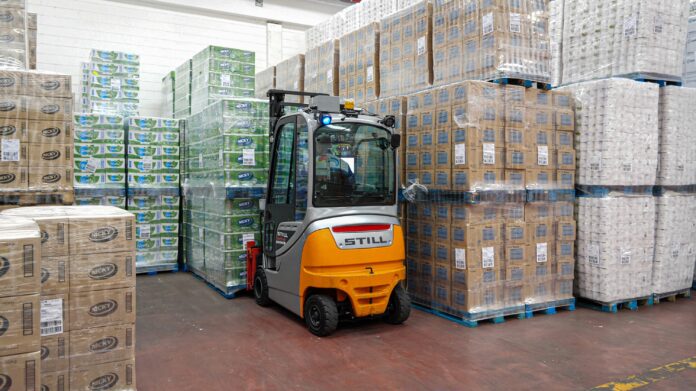With a record acceleration, a maximum travel speed of 21 km/h and further improved lifting speed and height, the new electric RX 60 25/35 forklift trucks by STILL combine the agility, the acceleration, the dynamism and the prompt braking of electric forklift trucks with the high-performances that in the past only diesel or LPG forklift trucks could assure. Due to these characteristics, RX 60 25/35 are suitable for applications in various sectors, like logistic, food & beverage and mechanical industry, offering notable use versatility: from loading and unloading operations of lorries to the horizontal transport of load units, from the stacking in shelves with maximum height of 7390 mm to commissioning and good preparation operations.
As perfectly knows Sofidel Group, world top player in the production of tissue paper for hygienic and domestic use, which has decided replacing all thermal forklift trucks in operation in its production sites and warehouses with electric forklift trucks.
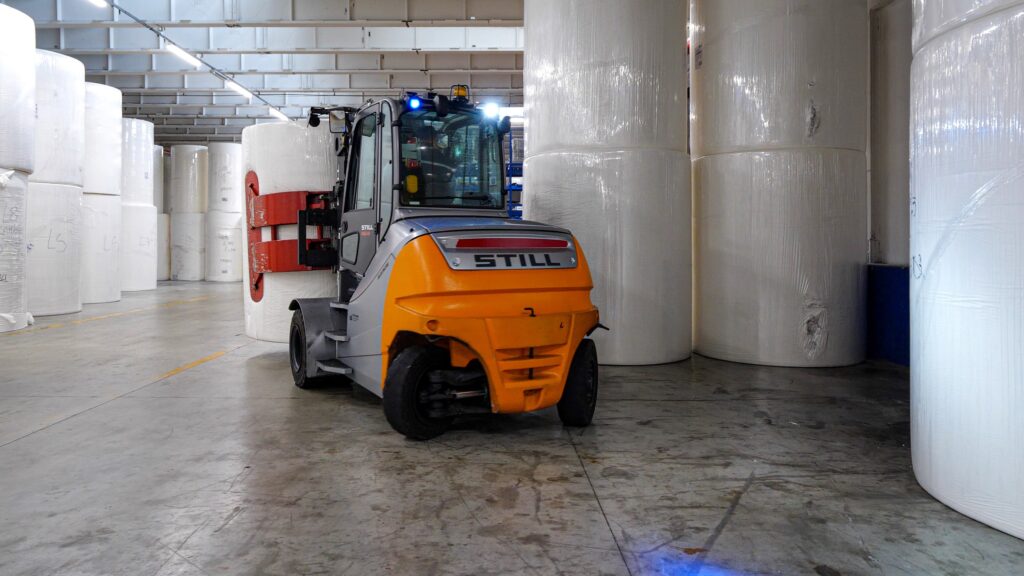 Today, in Italy Sofidel can rely on a fleet composed by over 160 STILL forklift trucks– prevailingly electric frontal RX 20 and RX 60 – which are used for all activities, from the handling of raw materials to the finished product stocking in warehouse and the loading on lorries. To meet the specific requirements of the paper industry, most forklift trucks are provided with special equipment, like the grippers studied to handle cellulose bales or paper rolls. Moreover, 2 of them have been recently equipped with innovative traceability systems aimed at assuring the highest safety of the work environment and at optimizing the allocation of pallets and the courses travelled by means. Equipped with detection antenna and forefront Tag RFID reading systems, they have become an essential component of the IREAD4.0 system implemented by Sofidel for the monitoring and the automatic management of goods and forklifts trucks.
Today, in Italy Sofidel can rely on a fleet composed by over 160 STILL forklift trucks– prevailingly electric frontal RX 20 and RX 60 – which are used for all activities, from the handling of raw materials to the finished product stocking in warehouse and the loading on lorries. To meet the specific requirements of the paper industry, most forklift trucks are provided with special equipment, like the grippers studied to handle cellulose bales or paper rolls. Moreover, 2 of them have been recently equipped with innovative traceability systems aimed at assuring the highest safety of the work environment and at optimizing the allocation of pallets and the courses travelled by means. Equipped with detection antenna and forefront Tag RFID reading systems, they have become an essential component of the IREAD4.0 system implemented by Sofidel for the monitoring and the automatic management of goods and forklifts trucks.
Only electric forklift trucks in Sofidel Group factories from now onwards
Electric boats: a “Tesla” in the waves
Among the companies that are trying to bring the electric motor in the world of boats, there is the Seattle start-up Zin Boats, which aims at producing electric boats and at ranking on the market to propose “the Tesla of the sea”, so demonstrating that electric boats can be a valid alternative to those powered by fuel. For this reason, the product conceived by the company is called Z2R, a 20-foot speedboat powered by BMW batteries, with 160-kilometre autonomy.
Z2R weighs around half of a standard boat of the same size. Weight is a fundamental matter: to move a boat, more power is necessary than the one needed for a car, a limit that hindered the previous electric experiments, carried out on boats in the Sixties.
The current lower cost of lithium-ion batteries is giving the opportunity of experimenting in this issue. Those used by Z2R, with a cost of about 250,000 dollars, are BMW-branded, able to power a Torqeedo motor that reaches speeds of 30 nodes. The autonomy is 160 kilometres, not exceeding 15 nodes.
Electric cruise motors under testing for NASA’s first all-electric X-plane
An important step forward for the X-57 Maxwell, NASA’s first all-electric X-plane.
Several rounds of tests, high power, and endurance testing are undertaken at Empirical Systems Aerospace, or ESAero, of San Luis Obispo – California, to verify that the electric cruise motors are ready before they are installed in the X-57 vehicle itself.
X-57, modified from a Tecnam P2006T airplane, is currently in its first of three configurations as an all-electric aircraft, called Modification II, or Mod II.
Only at last phase 12 smaller high-lift motors along the wing’s leading edge will be ready to be activated during takeoff and landing.
All three mods of X-57 will utilize the same cruise motors and these verification and validation steps are to reduce risks and increase the safety and reliability of the components on the vehicle.
The results from cruise motor functionality acceptance and qualification tests will help in the effort to set airworthiness standards for electric aircraft.
Business platforms and electric motors manufacturing processes
What, in the middle of the alert state of the first months of the current 2020, proved to be useful to the health sector – open shared innovation, the contribution of “brains” distributed in several continents, the development of the additive manufacturing and the fast shift from ideation to creation – is and will be precious elsewhere, too.
For instance, in the ambit of R&D concerning electric motors.
As witnessed by the case of the small producer of French electric cars, XYT, which has become part of 3DExperience Lab network of Dassault Systèmes to benefit from functions in cloud modality.
According to the data highlighting that the average motorist travels in Europe on distances largely under 100 kilometres daily, the goal was proving that interesting market shares still exist for EV, in short-range mobility, too.
Pixel Y, the modular vehicle
The idea, based on a concept structure called Pixel Y, was giving birth to a modular vehicle whose 580 parts (against the around 10,000 of a standard car) can be assembled several times at will and according to the requirements «with a normal toolbox».
Tested for the mileage of one million kilometres overall and optimized for urban deliveries, the model was the founder of a family extended to Pixel X, dedicated to logistics, and about to include Pixel T seven-seat shuttle, too.
![]() «XYT», Dassault Systèmes informed, «has become part of 3DExperience Lab to have access to the 3DExperience platform in cloud to accelerate its mission. The company is ready to collaborate with local and global talents in all fields: from design to engineering, from supplies to customizations. Our software solutions allow the company to carry out configurations and customizations dynamically and quickly, starting from the typical modular architecture of XYT».
«XYT», Dassault Systèmes informed, «has become part of 3DExperience Lab to have access to the 3DExperience platform in cloud to accelerate its mission. The company is ready to collaborate with local and global talents in all fields: from design to engineering, from supplies to customizations. Our software solutions allow the company to carry out configurations and customizations dynamically and quickly, starting from the typical modular architecture of XYT».
The partnership with the network of Labs provides for the unified access to Mobility Development Kits by XYT and the respective open innovation contents, besides the management of a fabric of workshops (they have planned 1,000) and relative operations of work planning, delivery and assembling.
The rhythm of batteries
Wherever there is an electric car, we need a smart, fast and green recharge system. SparkCharge, established in 2014, has added portability features to these characteristics.
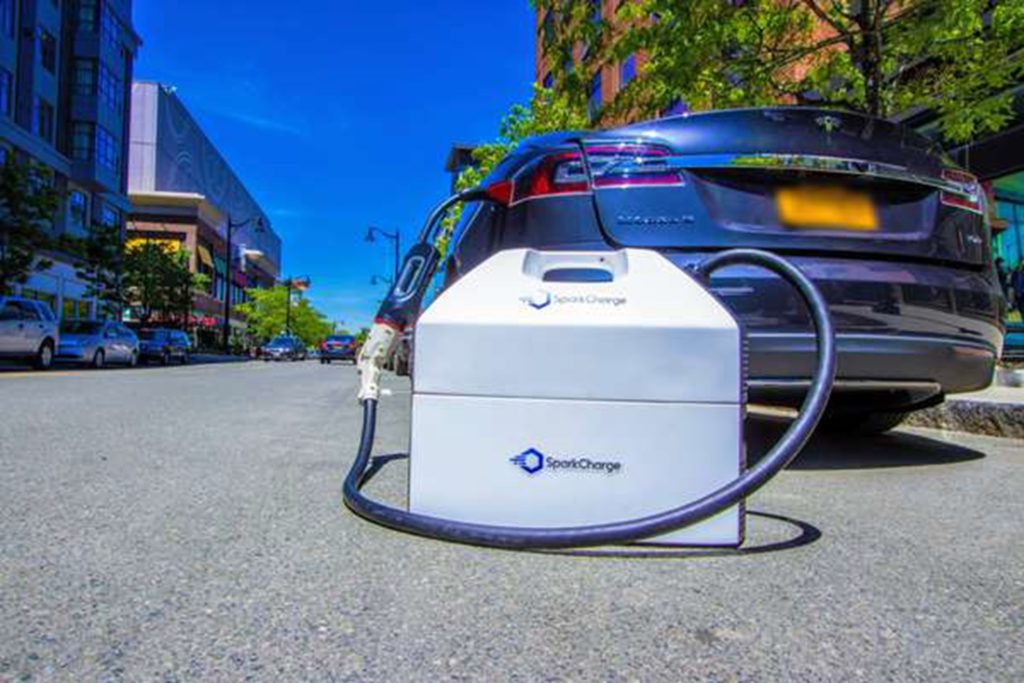 Its compact batteries, for whose development it is establishing partnerships energy providers, assure an additional autonomy of one mile per each minute of connection to the network to electric vehicles. In other words, in just ten-twenty minutes the driver of an EV broken down can recover, with all probability, the sufficient energy to return home, at least, safely. To guarantee the compatibility of the accumulator with the broadest possible number of vehicles, the company has exploited the 3DExperience platform and, especially in design phase, on Solidworks. Catia 3D has been used mainly in the passage phase to rapid prototyping while Netvibes Intelligence allows aggregating contents from various online sources, socials included, to orient future industrial developments according to users’ comments.
Its compact batteries, for whose development it is establishing partnerships energy providers, assure an additional autonomy of one mile per each minute of connection to the network to electric vehicles. In other words, in just ten-twenty minutes the driver of an EV broken down can recover, with all probability, the sufficient energy to return home, at least, safely. To guarantee the compatibility of the accumulator with the broadest possible number of vehicles, the company has exploited the 3DExperience platform and, especially in design phase, on Solidworks. Catia 3D has been used mainly in the passage phase to rapid prototyping while Netvibes Intelligence allows aggregating contents from various online sources, socials included, to orient future industrial developments according to users’ comments.
Formula E, the driving simulator of BMW Group
Among the leader brands in the ePrix competition ranks Bmw, which for the sixth Formula season has engaged the 23 years old German Maximilian Günther.
The pilot has recently expressed very positive impressions about the simulator: «It is the best instrument to get ready for races and to develop the car. We can try whenever we want and repeat the same things, to compare, then, the data we survey».
Technical remarks were explained by Rudolf Dittrich, General Manager of the development of Bmw motorsport vehicles: «With the simulator we can test things that we could hardly do on the track, besides testing on different tracks in the same day, imagining any possible scenario». The simulator is important for pilots but also for the entire team, especially after the reduction of official test days.
During the simulation, the pilot wears a helmet for both safety reasons, since the system is in motion, and to have the same field of view as during the race.
A solution to power motor control
Through the completion of the distribution system for MSFS motor starters for automation boards, Eaton makes available for its customers a solution to power motor control and protection circuits enriched with numerous novelties, including a 125 A power supply module, new adapters for modular and box-type switches and a 5 A /24 VDC power supply.
The distribution system has been designed to offer a safe solution for the distribution inside the automation board and it is now equipped with a 125 A power supply module, hence the nominal capacity of the bus bars of the system itself. This allows using MSFS at its highest use current, permitting its full exploitation, while the previous limit was 80 A.
The system is positioned between the base solution, constituted by three-pole bus bar blocks, and the higher-level solution characterized by SASY60i distribution bus bar system, therefore defining a new intermediate standard in terms of cost, versatility and current values for automation systems.
Eaton, in the context of the widening of MSFS system, now proposes new adapters that extend the MSFS use also to utilities not strictly connected with the motor starter. This is possible because they allow connecting to the system both modular FAZ switches up to 63 A and the box-type NZM1 switch up to 125 A.
Meanwhile, in the suitable version (ROSF), also the new hybrid EMS2 starters (Electronic Motor Starter) can be coupled to the MSFS system.
Moreover, among the novelties the system completion provides for, there is also a three-phase 5 A /24 VDC power supply that, in most of automation applications, allows powering 24 VDC auxiliary circuits of the electric equipment of a machine without providing for further power supplies. Finally, the adapters offered until now for «PKZM0/PKE + soft-starter DS7» combinations extend their use possibility also to variable-speed DE1(1) starters up to 1.5 kW.
Self-lubricating polymer bearings
In many applications, bearings and supports must work also in presence of filth, dust and chips. For this reason, they need continuous lubrication and maintenance interventions. Polymer bearings by igus are lubrication- and maintenance-free, even if the support is made of metal. Precisely for these systems with metal supports, igus has developed new iglidur J high-performance plastic bearings.
The new self-lubricating bearings with sheet metal housing allow notably decreasing maintenance costs. Moreover, this new material prevents the deposition of dirtiness and dust and this represents a considerable advantage in terms of wear and allows avoiding unforeseen machine downtimes. Igubal bearings are made through injection moulding and they are economically advantageous.
They can be mounted in few seconds to replace ball bearings in already existing standard metal housings or they can be bought with a low-cost sheet metal support. The joint is composed by the sheet metal housing and by igubal ball bearing and is directly available in stock. The plastic bearing has high resistance to wear and features a very low friction coefficient in dry operation.
Currently, igubal bearings are available in three sizes for low-cost sheet metal housings (Ø20, 25 and 30 mm) and for injection moulded housings (UC204-210).
Battery system simulation software
To Support Advanced Electric Vehicle Battery Systems Design, Altair, a global technology company providing solutions in product development, high-performance computing and data intelligence has announced the addition of the CellMod™ Virtual Battery by Sendyne to the Altair Partner Alliance (APA). So, CellMod™ Virtual Battery and BasicPackMod by Sendyne are now available for use by Altair HyperWorks™ customers.
CellMod™ is the first lithium-ion virtual battery capable of predicting cell and pack behavior, including thermal behavior, with an accuracy of better than 97 percent under a wide range of test conditions. Utilizing a sophisticated electrochemical model, CellMod is packaged as a functional mock-up unit (FMU), allowing it to be easily integrated into most major simulation packages, such as Altair Activate®, via the open industry standard functional mock-up interface (FMI).

After all, improving battery system performance is critical to facilitating the projected global electric vehicle market growth. An accurate battery model is the starting point for battery pack design, system control and optimization. The simple equivalent circuit (EC) models that are typically used today lack predictive power and are insufficient to the task. Taking a physics-based approach to simulating integrated systems that is accurate and runs faster than real-time can significantly improve the design of battery-based systems and optimize their long-term performance and safety.
Unlike EC models, CellMod accounts for physical processes taking place inside the cells, including diffusion in solids, diffusion in electrolytic solutions, reaction kinetics, charge transport, heat transport, etc. Because of this, CellMod can predict battery cell behavior with a high degree of accuracy.
Custom-tailored materials for metal pretreatment and functional coating
As part of its active global support for the metal coil industry, Henkel is partnering with major coil producers to implement dedicated process solutions for end applications in e-mobility. In addition, the company is also addressing demands for reducing the complexity of downstream manufacturing steps by enabling continuous upstream functional coating processes without compromising the technical properties of the coated material.
Metal coil producers play an essential role in the market of hybrid and fully electrical vehicles, supplying steel and aluminium coils to the manufacturers of batteries, transformers, converters, wound cores, shunt reactors and other key components for e-drive and electrified powertrain systems.
Henkel’s process know-how extends across the entire value chain from the rolling oil for electrical steel to specific pickling inhibitors and cleaners to specialized new functional and conductive thin coatings, such as for covering the aluminium foil used in EV battery systems. Besides providing reliable corrosion protection for painted or unpainted substrates, these products have been custom-tailored to improve the overall performance of e-mobility applications by enhancing insulation and bonding properties, magnetic permeability and electrical conductivity.
Latest product innovations targeted at both upstream and downstream metal pretreatment and functional coating for end products in e-mobility include Bonderite O-TO dedicated product range and Bonderite M-CR 12 series. Bonderite is a registered trademark of Henkel and/or its affiliates in Germany and elsewhere.
Electric drives improved in density, efficiency and reliability
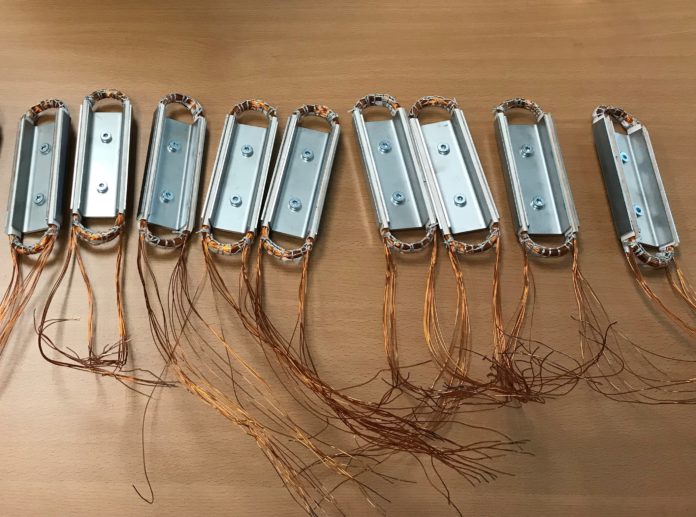
RAISE European Project, coordinated by the group of Electrical Machines and Drives – MeltingLab of University of Modena and Reggio Emilia (UniMoRe), aims at offering solutions to improve the reliability of power converters, of machines and of the entire electric drive, without damaging their performance and efficiency. Benefits and ameliorations that are likely to exert positive repercussions in both the short and the long term, besides being exploited by manufacturers to face the competitive Asian market.
In recent years, the need of implementing increasingly powerful, light and efficient electric and electronic devices has become a priority target in all industrial sectors. For this reason, the release on the market of new wide bandgap based power devices, made of silicon carbide (SiC) and gallium nitride (GaN) semiconductor materials, has aroused lively interest in scientific and industrial communities.
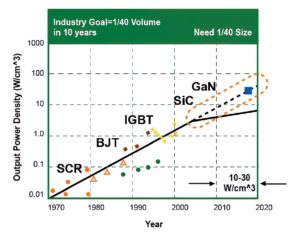
Automotive and aerospace industries rank among those that can most benefit from these devices.
In this context, according to recent development trends focused on “More Electric Vehicle” (MEV) and “More Electric Aircraft” (MEA), the replacement of hydraulic/mechanical actuators with electric drives implies a neat improvement of efficiency and power density, which means also weight reduction, minor fuel consumption and lower emissions of noise and polluting substances.
The added-value of wide bandgap based power devices
The converters based on wide bandgap power devices feature superior characteristics than conventional devices based on silicon (Si). Such devices offer faster switchovers, minor power losses and they can operate at higher voltages and temperatures than their silicon counterparts, so allowing also a further reduction of volume and weight in converters’ cooling system.
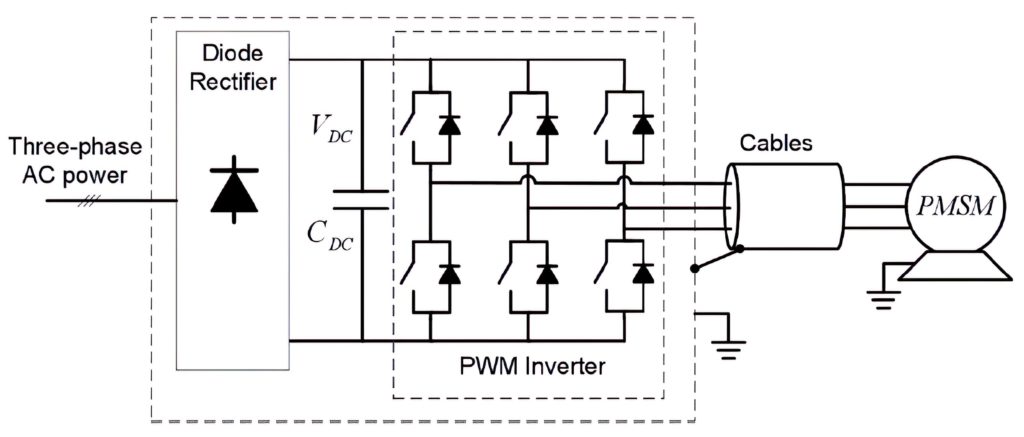
«It is then clear – explains Dr Stefano Nuzzo, member of the research team of UniMore, University of Modena and Reggio Emilia, “Electrical Converters, Machines and Drives”, together with Professor Davide Barater, Professor Giovanni Franceschini and Mr Marco Pastura – that the new devices based on SiC and GaN semiconductors materials perfectly match the above-mentioned targets».
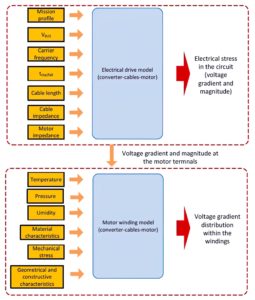
However, the electric stress combined with the high voltage gradients they can reach, in addition to the combined action of other environmental stresses (like temperature, pressure and humidity) can shorten the life time of the insulation system of electric motors powered by converters that use SiC and GaN semiconductors.
Therefore, reliability problems can emerge in this type of electric drives. Moreover, the physical length of the power supply cables that connect the power converter to the motor can be comparable, or even exceed, the so-called “critical length”. «In this case – Dr Nuzzo underlines– the high rising and falling voltage pulses make cables behave like transmission lines, with waves that travel forward and backward along cables themselves due to the reflection phenomenon. These high-frequency phenomena can cause dangerous overvoltages at motor terminals, up to twice the direct-current bus voltage, the worst case, which can seriously damage the electric insulation of motor windings».
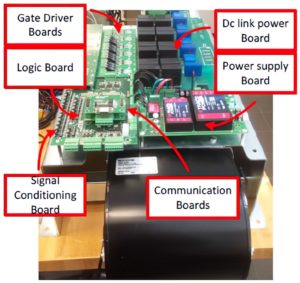
In particular, if the values of the dielectric rigidity of insulations are exceeded because of voltage levels at electric motor terminals, conductive phenomena through a portion of the insulation material occur, leading to the so-called partial discharge phenomenon. Partial discharges occur on the surface of the electric insulation, causing a progressive erosion up to the complete breakdown. The critical length is proportional to the switchover time, therefore the very short switching times of SiC and GaN devices have made the cable use problematic even for an extension of few metres. Besides, electric power transmission networks currently proposed for aircrafts are addressing the use of higher and higher voltage levels on bus in direct current, to minimize conduction losses.
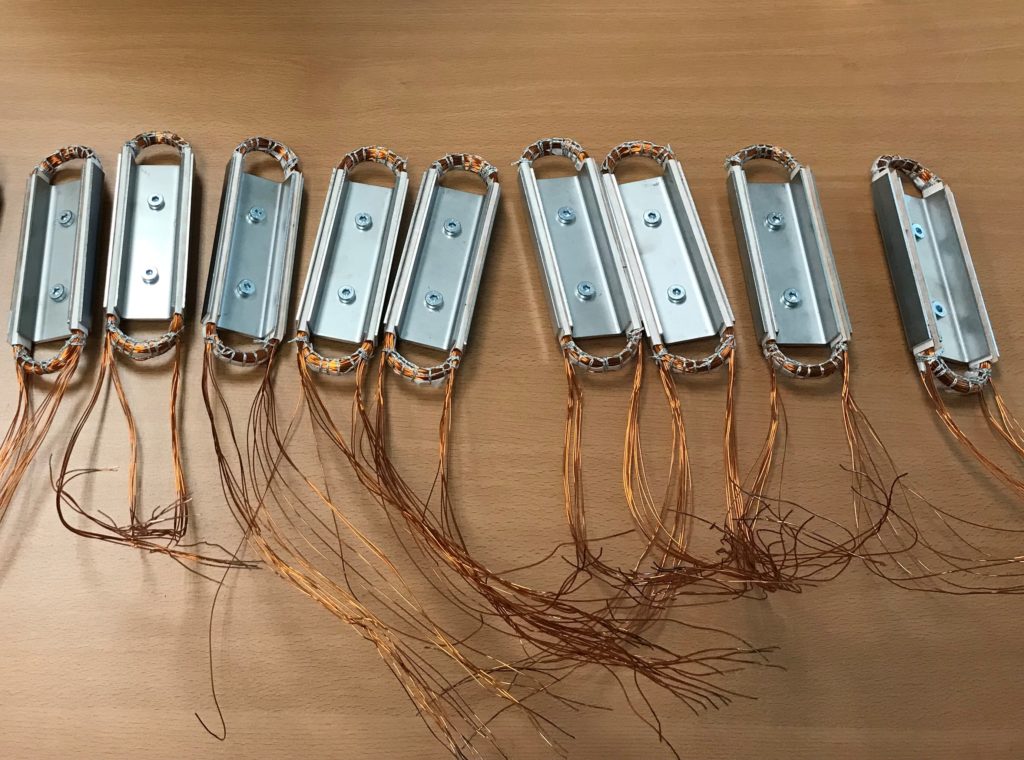
However, the voltage rise on bus in direct current causes a further stress on the stator winding insulation, thus worsening the issues connected with the use of wide bandgap based devices.
From the state-of-the-art to the progress beyond it
The project RAISE – “Reliable Aircraft electrical Insulation sElection” is framed in this context. The project, started in March 2018, is funded by Clean Sky consortium, the primary research programme on European scale, included in Horizon 2020 funding system, which aims at the development of innovative solutions for the reduction of CO2, of greenhouse gases and of the acoustic pollution. The group of Electrical Machines and Drives – MeltingLab of University of Modena and Reggio Emilia (UniMoRe), led by Professor Giovanni Franceschini, is coordinator of RAISE project and Professor Davide Barater is its Principal Investigator. Other two members of the MeltingLab assist their work in the project: Dr Stefano Nuzzo himself and Mr Marco Pastura. «MeltingLab – Dr Nuzzo specifies – collaborates with the main groups of the Department of Engineering “Enzo Ferrari”, of which it too is part, and cooperates with the most renowned area companies operating in the sectors of automotive, electric drives, industrial electronics and electrical machines».
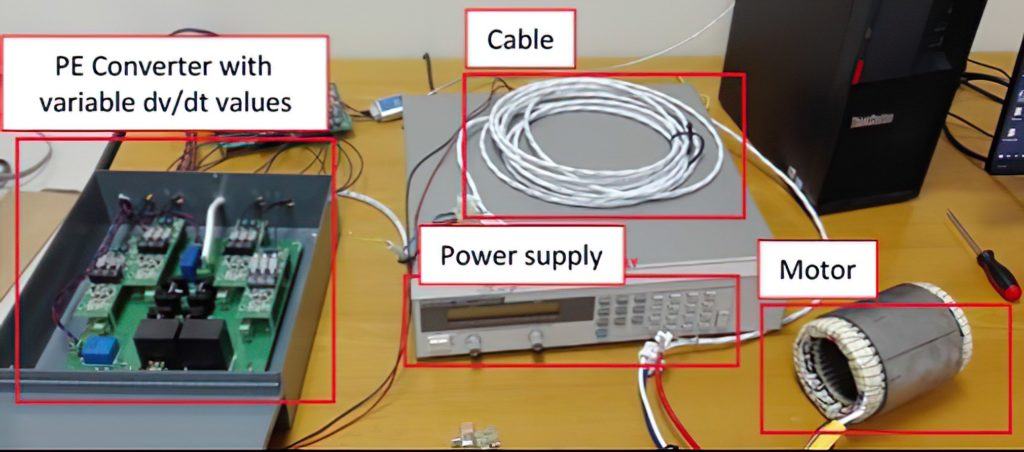
In the last years, the group’s research has focused on electric mobility, mainly working on the design of electric drives for the control of high-performance electric motors through advanced prototypes of power converters with SiC modules, and on the design of electric machines featuring high efficiency and reliability.
Considering all criticalities previously highlighted, it is worth first of all assessing whether the insulating materials currently in use in electrical machines and in electronic power devices are suitable for applications that exploit higher and higher power supply voltages and switching gradients, such as in the case of the wide bandgap based semiconductors previously mentioned. Therefore, the first phase of RAISE project was committed to the analysis of the state-ofthe-art and to the experimental evaluation of insulation materials and systems used in in current aerospace applications. Afterwards, to better understand the impact of high voltage gradients, they have developed some models to quantitatively assess the values observed in a typical system composed by power converter, cable and electric machine, considering the typical operating conditions of the aerospace environment and the dependence on the alternating voltage (three-phase at 115 Vrms versus 230 Vrms).
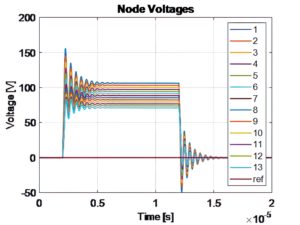
The limit for the direct-current bus voltage was fixed at 1 kV, while the maximum voltage gradient considered is 20 kV/µs. Nevertheless, for these studies, they have considered also higher voltage and gradient levels, which might be reached in the next future. «These models – Dr Nuzzo specifies– can assess also the voltage distribution inside the windings of the electric machine and its dependence on the key parameters of the machine».
(UniMoRe) and University of Bologna (UniBo). UniMore leads the consortium as project coordinator whereas the company LiebherrAerospace, multinational operating in the aerospace sector, acts as Topic Manager for the project. RAISE aims at investigating and assessing partial discharges and breakdowns of electric insulation in electrical machines’ windings driven by wide bandgap converters of silicon carbide (SiC) and gallium nitride (GaN). Goal of the project is offering solutions to improve the reliability of power converters, of machines and of the whole electric drive, without damaging performance and efficiency. Consequently, the aircraft of the future, besides being “more electric”, will be more reliable, more compact and lighter, and fuel consumptions and the environmental impact, mainly measured on CO2 emissions, will be drastically reduced. It will be possible to transfer conceptually and practically the results of the project to the automotive industry, where the same electrification trend is taking place.
Innovative methodologies to reduce high voltage gradients
The project subjected to in-depth study is also aimed at verifying when the partial discharge phenomenon on insulation systems starts. «In this second phase, – Dr Nuzzo highlights – we developed some models based on the estimation of components’ life time and we carried out some experimental tests aimed at studying the impact of the voltage variation speed on partial discharges.
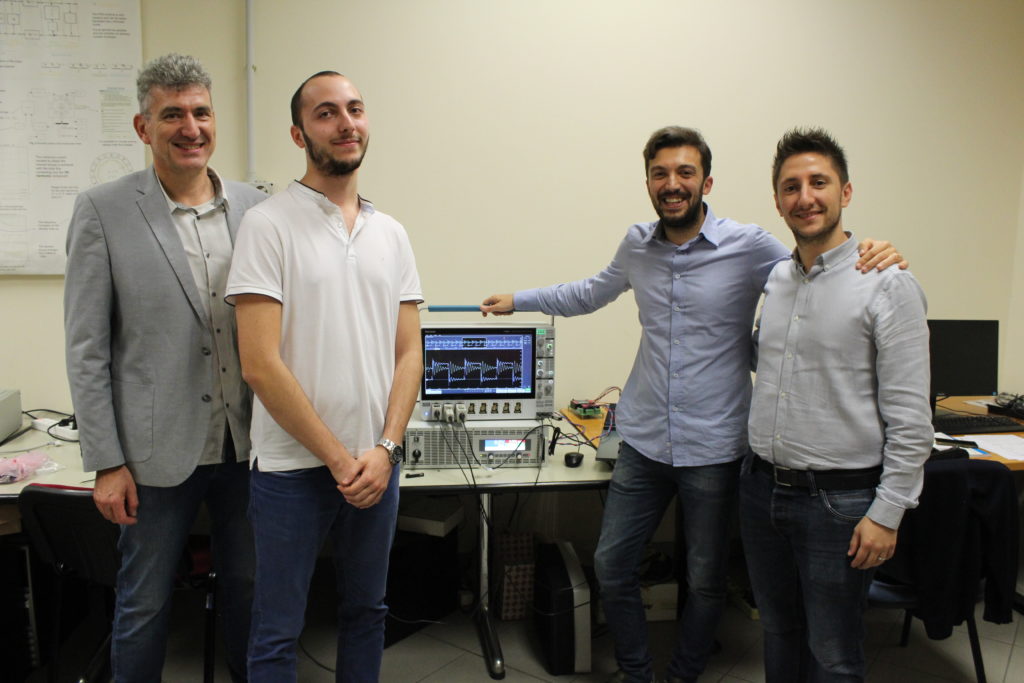
The investigation was executed considering also the variations of environmental conditions in terms of temperature, humidity and pressure».
The final goal consists in making the developed models represent some guidelines for the detail design of components “free” from partial discharges, through the estimation of the service life of insulation systems. The capability of designing insulation systems free from partial discharges will allow then granting the reliability of all the components of the electric system at stake and consequently of the entire aircraft.
(by Gianandrea Mazzola)

